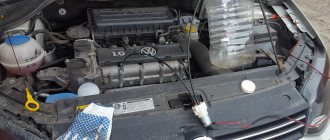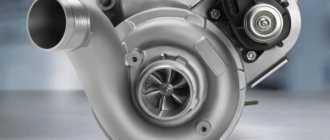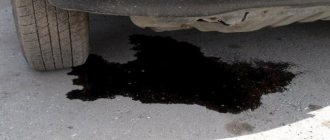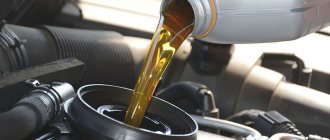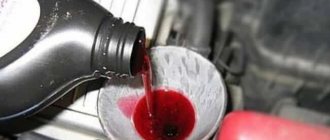Engine flush is a chemical additive designed to clean accumulated deposits, sludge, and other contaminants from your engine. You pour it into the engine oil filler hole and idle for about 10-15 minutes. It mixes with the oil and circulates through the engine, helping to dissolve sludge and clean deposits. Then you drain the oil (along with most of the debris), change the oil filter, add fresh oil and get back to driving. To determine which flushing oil is best to use, you need to familiarize yourself with the options available on the market and their features.
Do I need to use flushing oil?
Let's get straight to the point. There are situations in which it makes sense to use flushing oil. But in some cases this is not necessary.
Let's look at situations in which flushing the engine with specialized oil will be relevant.
- Changing regular motor oil to a fundamentally different one based on the base or package of additives used. In this case, there is no urgent need to clean the crankcase from the remains of old lubricant. However, it won't hurt to flush the engine. Motor oils are mostly similar in the type of base and additives used. And at least if they are partially mixed, nothing bad will happen. But there are oils on the market with unique characteristics or composition. For example, these include lubricants with molybdenum or esters. Here, before changing the oil, it is advisable to flush the crankcase to remove as much of the old grease as possible.
- Significant mileage between regular maintenance. After the specified service life, oil begins to clog the engine and settle in the grooves and recesses of the engine in the form of sludge deposits. Flushing oils are used to remove these deposits.
- Detection of significant sludge deposits under the valve cover or in the pan. In this case, it will also not be superfluous to fill in the flushing lubricant. Low-quality lubricants, even with timely replacement, gradually contaminate the engine.
Manufacturers of engine flushing oils recommend using their product during every maintenance. However, there is no real need for this. This is a commercial move. If the oil is changed on time and the valve cover is clean, there is no point in using a chemically aggressive flush.
The cleaning components of flushing oils are much gentler and safer than those of the so-called five-minute oils. But, nevertheless, flushing oils still have a negative effect on engine oil seals.
The effect of flushing oils on oil seals is ambiguous. On the one hand, the alkalis and light hydrocarbons contained in these products soften hardened oil seals and can even partially reduce the intensity of leaks through them, if any. On the other hand, these same means can reduce the strength of the oil seal, causing its working surface to deteriorate at an accelerated pace, and the engine will begin to “snot” over time.
Therefore, flushing oil should only be used when needed. There is no point in regularly pouring it into the crankcase.
Choosing the best oil
The best flushing agents are essentially mineral or semi-synthetic oils. Moreover, even service specialists cannot always identify the best of them.
Choosing an engine flush is not difficult if you remember what kind of regular oil is poured into the engine. If it is synthetic, then the flushing should be based on this. For mineral oil, the same flushing agent should be used. By and large, information on recommended oils can be found in the car manuals. You should rely on it when choosing. At the same time, we should not forget about the brand under which the wash is produced.
Domestic car enthusiasts prefer products from the following brands:
- ZIC . South Korean oils and washes are produced under this brand. They have good characteristics. In addition, such products prevent corrosion and prevent lubricants from foaming when overheated. ZIC brand products do not harm various gaskets and seals. With regular use, you can be sure of the cleanliness of the engine.
- Rosneft . A domestic manufacturer produces good mineral washes, which mainly use foreign additives. The products of this company can be used for flushing both gasoline and diesel engines. Recommended for those car owners who switch from one oil to another after a long mileage.
- Spectrol . This is another domestic brand. Its products allow you to get rid of sediment that remains in the engine after skipping routine maintenance. Despite their excellent cleaning properties, Spectrol washes are non-abrasive.
- Luxe Motor Flush . This flush is based on mineral oil. It contains additives that increase the efficiency of removing toxins from the internal elements of the power unit. It is able to dissolve low-temperature deposits and clean the oil receiver.
- Liqui Moly . German washes are considered safe and effective. They gently and carefully remove dirt from all elements of the power unit and do not harm the seals. After use, a protective layer remains on the internal surfaces of the engine.
- TNK . This company produces 2 types of washing agents: standard and express. They can be used for any type of propulsion systems. They contain all the necessary additives for effective cleaning. After use they fade completely. Works well with other oils.
This is interesting: Photos of Chevrolet Cruze interior, review of design innovations
This is not a complete list of popular washes. When purchasing them, there is less chance of running into a fake than when purchasing cleaning products from other brands. The manufacturer protects its product as much as possible.
Lukoil flushing oil
Perhaps the most popular and discussed flushing oil on the Russian markets is Lukoil. It costs an average of about 500 rubles in retail sales for a 4-liter canister. It is also sold in 18 liter containers and in a barrel version (200 liters).
This product has a mineral base. The composition includes a complex of calcium-based cleaning additives. Zinc-phosphorus components ZDDP are used as protective and anti-seize components. The content of ZDDP compounds in the flushing oil is low. Therefore, they are clearly not enough for full engine operation. This means that flushing can only be done at idle speed. If you put a load on the motor, this can lead to the formation of scuffing on the friction surfaces or accelerated wear.
According to reviews from motorists, Lukoil is a good flush that can quite effectively clean the engine of not very old deposits.
How to clean the engine
There are several methods for removing deposits from an engine, differing in complexity, degree of impact on the unit itself, processing time and cost.
- Sometimes the use of flushing compounds does not bring the desired effect, and starting a contaminated engine is simply dangerous. In this case, you cannot do without disassembling the motor. This can be done either independently or at a service station. In this case, each engine part is cleaned manually (with solvent, kerosene, etc.). After processing the components, the unit is assembled (it is possible to assess its condition in detail) and installed in place. Of course, not every car owner has the conditions to carry out such repairs and the appropriate knowledge.
- You can flush the engine with oil, which you plan to fill in later. The procedure is not complicated: new oil is poured into the engine and drained after a mileage of 1.5. 2 thousand km.
- Liquids called “five-minute fluids” allow you to quickly flush the power unit. These compositions, containing phosphorus and zinc additives, solvents and other components, are quite aggressive, so they effectively dissolve various formations in the motor (but at the same time can negatively affect sealing elements and metal). The flush is added to the old oil, after which the power unit should run at idle for several minutes. The procedure is completed by draining the waste, changing the filter element and filling in a new lubricant.
- Long exposure washes work in a similar way. The only difference is that the product is added to the engine and to clean it, you need to drive the car for about 100 km, after which you can change the lubricant.
- Flushing oil allows for gentle cleaning of the engine. This mineral-based lubricant with detergent and anti-seize additives is usually sold in 4 or 5 liter containers. Cleaning scheme: flushing liquid is poured (the volume corresponds to the amount of oil usually used in the engine) into the power unit after draining the used oil. The engine should idle for some time (do not accelerate). After this, the flush is drained, the oil filter is installed and fresh oil is added. This method, characterized by its safety and gentle effect on the components and parts of the unit, is considered more acceptable for removing deposits than the use of aggressive compounds.
Flushing oil "Rosneft"
Another well-known product on the Russian market is Rosneft Express flushing oil. Available in containers of 4, 20 and 216 liters. The estimated cost of a 4-liter canister is 600 rubles.
Rosneft Express flushing oil has been created on a mineral basis for deep purification with the addition of detergent-dispersant additives. Removes soot and sludge deposits from oil channels, timing and timing gear parts and surfaces of body parts. Retains finely dispersed contaminants in its volume, which tend to precipitate and not be drained when changing the oil.
Rosneft Express flushing has a gentle effect on oil seals and does not destroy the rubber structure. During washing, normal operation of the car is not allowed, since the additive package is traditionally poor for such compounds.
Flushing oil "Gazpromneft"
At car repair shops you can often see Gazpromneft Promo flushing oil. This product is positioned as a mild cleaner for all types of engines.
This oil is produced in canisters of 3.5 and 20 liters, as well as in a barrel version of 205 liters. The price of a 3.5-liter canister on the market is approximately 500 rubles.
The kinematic viscosity of the Promo flush is 9.9 cSt, which according to the SAE J300 classification is equivalent to a high-temperature viscosity of 30. The pour point is about –19°C. Flash point +232°C.
Thanks to a good package of detergent and dispersant additives, the composition has minimal impact on rubber and aluminum parts of the lubrication system. A small content of anti-wear and extreme pressure additives allows you to reliably protect the engine during cleaning, if it is not subject to increased loads.
Flushing oil MPA-2
Flushing oil MPA-2 is not a separate brand, but a general name of the product. Stands for "Automotive flushing oil". Produced by several oil refineries: OilRight, Yarneft and simply small companies without branding.
MPA-2 is the cheapest option available on the market. The price is often below 500 rubles. Contains a simple set of detergent additives. On the one hand, such additives are moderately aggressive towards rubber engine parts and, when used in moderation, will not harm the engine. On the other hand, the cleaning efficiency is also not the highest.
Motorists say that this oil copes with cleaning not very old deposits. However, in comparative tests it is somewhat inferior to more expensive options. It is also worth noting that from different manufacturers, despite the available specifications for the composition, this oil differs somewhat in its effectiveness.
Disadvantages of flushing oils
Using oils to clean internal combustion engines has some disadvantages. It is not recommended to operate the power unit for a long time on flushing material. It has low viscosity, but does not provide high-quality lubrication of rubbing elements and heat removal from them.
Base oils already have additives with cleaning components. After cleaning the motor, about 5-10% of the cleaning solution will remain inside. When mixed with it, the lubricant will reduce its viscosity-temperature characteristics.
Work on flushing the power plant takes some time, but does not guarantee that slags and deposits will be removed in full.
Flushing oil ZIC Flush
In general, the products of the Korean company SK Energy have become widespread in Russia over the past few years. And ZIC Flush flushing oil was no exception.
ZIC Flush is created on a synthetic basis, on the proprietary SK Energy Yubase base. It has a very low viscosity: only 4.7 cSt at 100°C. It loses fluidity only after passing the –47°C mark on the thermometer. Flashes in a closed crucible after reaching a temperature of +212°C.
This oil is recommended for flushing engines that require low-viscosity lubricants. For example, for engines of modern Japanese cars designed for 0W-20 lubricants.
It is difficult to say unequivocally which is the best of all the flushing oils available on the Russian markets. Much of the final result depends on the degree of contamination of the engine, the sensitivity of rubber and aluminum products to aggressive alkalis and light penetrating hydrocarbons, as well as the quality of the flushing itself.
General recommendations include, at a minimum, choosing a wash based on the viscosity required for the car. If the engine needs 10W-40 oil as a regular oil, then you should not use low-viscosity flushing compounds. At the same time, it is also not recommended to use thick lubricant-flushes for Japanese high-speed cars designed for 0W-20 oil.
Top Rating of reliable radiator flushing fluids
Lavr 1103



